
People say math is just another language, and that the more you do it, the easier it gets. People also say that aliens abduct you in the desert so I don’t know.
You knew it had to happen though, didn’t you? Back in grade school the sour aunts were smug when they told you why you had to learn it – because you’d use it in everyday life. Nevermind that to an eight year old, Everyday Life is a concept about as tangible as the Dow. You’ll use it at the grocery store, they’d intone, and at the hardware store. Or when you decelerate a space shuttle orbiter from hypersonic speed and segue into the landing phase.
High school algebra was another toothy beast altogether. It was the one class in which I ever got a D, and then I followed up that stunt by lying my way to Mexico. Told my dad I’d pulled a B- so that I could go on my spring break trip, and by the time the report card arrived in the mail, I was the focus of a small health emergency unfolding in a medically equipped hut in the center of the Yucatan Jungle. My parents were so happy to see me alive that I never even needed the five-foot straw sombrero I’d haggled down to 55 pesos.
I still hate math. But I did need it for haggling.
Seems that on some level, every day, I need it for cooking too. Nuns didn’t tell me that or I might have tried harder. Every Day Kitchen Life requires a handle on the basics of subtraction, of fractional division, and multiplication. Granted, unless you’re baking most of this can be done using those other measuring instruments, the built-in kind: the nose, the eyes, the taste sensors, Most of all, there’s that nebulous know-how. If you’re like me and the very notion of multiplying 3 ¾ cups by 1 ¼ makes your head feel like someone crammed a few too many teeth in there, then you’ve put a spin on it. You’ve got people convinced that your frantic avoidance of math is really the highly developed, finely honed extra-sensory gift of intuition.
I’m not telling if you’re not.
And anyway, along comes Michael Ruhlman’s Ratio, and suddenly I find myself inspired to at least breathe deeply in the face of the math problem instead of running from the kitchen. Here’s why. Ratio: The Simple Codes Behind the Craft of Everyday Cooking (Scribner, 2009) is a culinary Golden Compass – it gives the home chef access to the inner workings of food. Before I go on though I better say this: In order for this to be much help, you already need to be pretty familiar with the outer workings of it. This is a book for those among us who aim to understand what we’re doing when we’re fiddling around in the kitchen.
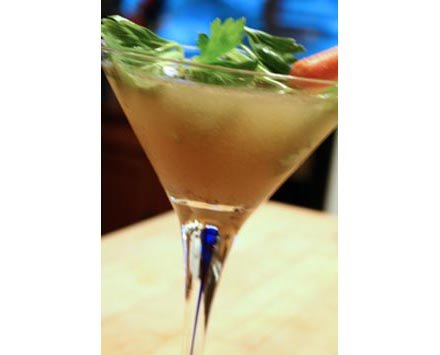 |
Ruhlman’s idea is an elegant one: great food is based upon a reliable ratio of the ingredients. When you know the simple proportions of one ingredient to another, you’ve nailed the backbone of culinary craft. Easy as 3:1:2. Three parts flour, 1 part fat, 2 parts liquid, that is. That’s the ratio for biscuit dough, as opposed to pie dough, which is 3 parts flour to 2 parts fat to 1 part liquid.
And that’s the real magic here. Drag the flour from your pantry, the butter or oil and the eggs from the fridge, and get some water ready and set up shop. Grab a large bowl, and start mixing. By shifting the ratio of flour to fat or liquid, with the addition or subtraction of egg, or by using one kind of fat rather than another, you can whip up biscuits, pie dough, pate a choux, bread, pasta, muffins, fritters, popovers or pancakes. Toss in some sugar and the possibilities include cookies and any number of cakes.
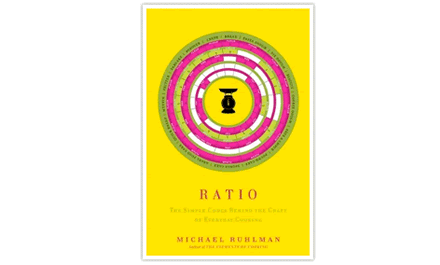 |
Of course, it’s not quite that simple. Bread requires yeast, and unless you’re trying for manna, baked goods call for leavening. Salt is requisite, and no matter what you’re making, if you fail to spice things up then you’ll have pretty dull, plodding food. You won’t find guidance about leavening, herbs, extracts, cheeses or other flavors here. Rather, Ruhlman says, this kind of expertise comes from experience, and experience is an important part of this equation. Consider his statement that the basic, unadorned 1:2:3 cookie dough is “a good recipe to do once so that you can understand what a cookie is.” The implication being that you’ll never do it again.
But Ruhlman does go on at length to explain the function of the other ingredients, if not their measurements, and he provides alternate recipes that have had the ratios tweaked so that we might begin to understand what happens when you modify the balance of ingredients. And the book goes far beyond dough recipes. Ratio is divided into sections: Doughs and Batters, Stocks, Meat-related Ratios, Fat-Based Sauces (including vinaigrette, mayonnaise and hollandaise), and the Custard Continuum (which has free-standing custard at one end and caramel and chocolate sauces at the other).
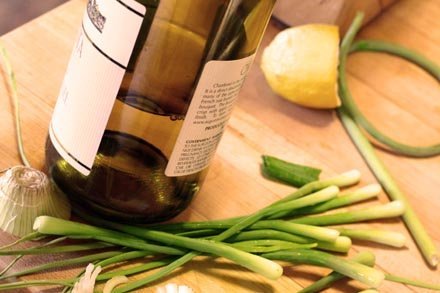
If you can get a handle on the ratios, then there’s a lot of freedom here. Say you want to make a little bit of bread – or a whole bunch. Rather than finding a recipe to suit your needs, or going through the hassle of modifying one, simply measure out the amount of flour you need. You have 21 ounces? If the ratio is 5 parts flour to 3 parts water then you’ll need… well, you’ll need… um… See, that’s why this book’s applicable value is limited for me. At least until the US goes metric.
I still love this book though. If you, too, are severely mathematically stunted, and if, unlike me you don’t live with a numbers whiz like Simon, I’ll still gamble that this book will be an incredibly enlightening resource (even though gambling is a numbers game). For one thing, every chapter is filled with gems and nuggets that you can carry straight into the kitchen. There’s as much on technique and chemistry as there is on ingredients, and technique is more than half the equation.
For example, in the section on vinaigrette, Ruhlman writes extensively about the order in which ingredients should be combined as well as how to attain just the right emulsification. As for stocks, he asserts that they deserve extraordinary attention since they infuse food with that je ne sais qua that separates home cooking from restaurant quality cuisine. Appropriately then, he covers techniques for extracting flavor, simmering times, and temperatures (stock should never boil), as well as methods for thickening and salting.
Every page of the book is a joy to read. Engaging, sometimes flip, and always deeply serious about food, Ruhlman writes with wit, honesty, and an almost ruthless candor. The book is an aesthetic paradox of a cookbook, heavy on text, relatively light on the recipes, yet punctuated throughout with the dramatic, artful black and white photography of Ruhlman’s wife, Donna Turner Ruhlman. And the ratio of photos to text achieves just the right balance.
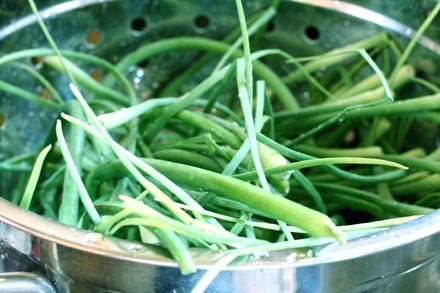
One of my rules about cooking (and writing) is to shamelessly break all the rules. But first you have to learn them – and understand them. Regardless of your skill level, Ratio gives you the tools for knowing, on a very elemental level, how to cook, and it provides inspiration as the why. Ruhlman’s culinary ratios hand you the plot of land and the bricks and mortar. The tiles, the hardwoods, the moldings and soffits and triple-hungs, those are up to you. And if you can achieve confidence in your ability to manipulate the formula, suddenly the skylight’s the limit.
The Recipe
If you’re planning to drive 451 miles to collect ten-plus pounds of heirloom garlic scapes, know this: you’re going to end up with a lot of garlic scape tops. This part is stringy and a bit grassy and not all that graceful on the tongue – in other words, this is the part that goes into the compost. Unless, of course, you can’t stand to waste anything that smells so tasty. Since I couldn’t bear to throw them away, I made mine into a wonderfully aromatic vegetable stock.
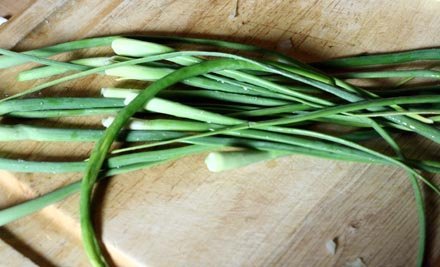
A few words on making a stock so heavily balanced toward the aromatics. Ruhlman’s soup stock ratio suggests that sweet aromatics –garlic, onion, carrots and celery,, etc – should comprise about 20% the total weight of a stock. You’ll be getting into pretty heady territory if you do what I do, but that’s okay – just be mindful when you’re using the stock. I don’t eat meat, so the heft of flavor is going to come from these pieces anyway. The aromatic broth is going to be ideal for cooking risotto, grains, or for using in lieu of some of the oil in a stir fry, for example.
There are several steps here that are important, and that can be used in any stock – not just a veggie stock that’s heavy on the allium.
- Toast the peppercorns. Ruhlman suggests toasting them briefly in a hot skillet until they let off a peppery, nutty aroma. Cool them slightly, crack them with the bottom of a small sauté pan, then add them to your stock pot..
- Deglaze. I knew that I wanted to make a fond to add depth and sweetness to my stock. To do this, you’ll need a stainless steel or other non-nonstick skillet.
- The slow un-boil: It is essential, when making a stock, to start out by placing your ingredients in cold water. Ruhlman explains that the ingredients shouldn’t ever boil, and in most cases shouldn’t even simmer. A gradual temperature increase will extract the most flavor without creating bitterness or emulsifying fat. In fact, Ruhlman suggests oven-cooking the broth at 180 degrees as the ultimate means of obtaining flavor.
- Stock in an hour or less: Vegetables are limited in what they can give up in terms of flavor, and they release all of it in a fairly short amount of time. After that they begin to disintegrate, turn bitter, and soak up valuable broth. An hour of cooking time will suffice.
- Just say NO to celery: at least in a vegetable stock. Celery overpowers the other, more delicate flavors.
Finally, if you don’t have ten pounds of garlic tops lying around, you can substitute with onion greens. These are milder than the roots and will add the same freshness and sweetness as the scapes.
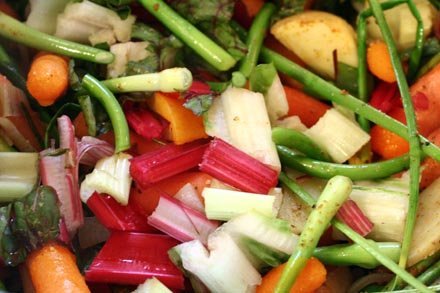
Garlic Scape Soup Stock
2 tablespoons olive oil
½ lb onions, diced
¼ pound mushrooms
1/3 cup dry white wine or white wine vinegar
2 pounds garlic scape tops (or other aromatics. This can include onion tops, carrots, or leeks)
¼ pound miscellaneous greens – chard leaves and ribs, spinach,
Generous handful of peppercorns
5 pounds (10 cups) water
Small bunch parsley
Small bunch fresh thyme
Bay leaf
Salt to taste
Preheat the oven to 180 degrees.
Heat a small skillet on medium high. Add the peppercorns and toast just until they begin to smell nutty. Remove from heat, crack them with the bottom of a skillet or a pestle and set aside.
In large stainless steel stock pot, heat the olive oil. Add the diced onion and mushrooms and cook on medium low until the onion becomes transluscent, about five minutes. Increase the heat slightly and let the vegetables begin to stick to the side of the pan. Pour in the wine or vinegar and stir the onion/mushroom mixture so that it is released from the sides of the pan. Remove from the heat.
Add the water, peppercorns, parsley, thyme, bay leaf, garlic scape tops and the leafy veggies. Stir well, then cover loosely with a lid and turn on the heat. Watch the pot carefully and don’t let it get too hot. When the temperature has reached about 180 degrees, place the stock pot in the preheated oven. Allow to cook for an hour, stirring the ingredients now and then.
Remove from oven, add the salt and then taste and adjust. This will store in the refrigerator for up to a week, or in the freezer for several months.
Tags: donna ruhlman, garlic soup stock, heirloom garlic scapes, michael ruhlman, ratio: The Simple Codes Behind the Craft of Everyday Cooking, scapes

I absolutely agree with you about Ratio. I’m a math retard too but I got so much from Michael’s writing. I made a meat stock for the first time actually after I read the book, as I didn’t know the part about not boiling either. Your stock looks good enough to sip in that martini glass, lol!
This is great information about making soup broth. We have a vegetable garden this year and so we’ve got a lot of “spare parts” to use up, like the chard ribs and broccoli stems and yes, scapes. Nice photos.
I totally need to get this book. Ruhlman rules, doesn’t he? It’s true that ratios rule the known universe… and I would have been totally lost without them when I made that wedding cake. And I can totally see the benefit of using them for making stock. I never measure things when I make stock anyhow, so I might as well memorize the rules.
Toasting the peppercorns is brilliant, really.
And I saved the bad joke for last.
Is Scape Stock a little like Woodstock?
ruhlman changed the way i cook – forever. and with ratio, i find i’m empowered to go where i’ve never gone before – without an actual “recipe”. it’s a perfect book. no wait – it’s a tool unto itself.
oh and for those of you who think angel food cake tastes like spongy sweet nothingness? try ruhlman’s… it’s in the book. and it’s wonderful…
now – how do i get some of that stock sent down from st. louis?
I think Ruhlman is on to something… something I’ve inherently followed in my style of cooking where I shirk recipes and opt for intuitive culinary creativity instead. Though, truth be told, I had it more like 3:2:1 (perhaps influenced from my excessive enjoyment of the old PBS series 3-2-1 Contact?). Still, I think there are some valid ideas he raises and anything to support my dissident, recipe-adverse ways is A-OK in my book. Good lookin’ scapes Becks!
Becky you’ve captured my attention with this post. I LOVE garlic and want some of yours ’cause I might not make my own stock.
I’m not a big cook book person I usually just acquire recopies online but in reading your review of Ruhlman’s RATIO I could picture my Grandmother and Great-Grandmother standing in their kitchens making biscuits with no recipie! I never got how they could do that – and they made lots more than biscuits that way. And I can’t tell you how often my husband and I come home from eating out and want to recreate a sauce or dressing and can’t get the ratio quite right. I too am less than a math whiz but this sounds like the kind of book that could help me understand why some things turn out well and others turn out soooo poorly.
Aliens abduct you in the desert… teehee. Clever. I doubt I’ll ever go to the trouble of making my own stock but I still enjoy reading.
Great concept this Ruhlman has. I’ll check out the book. And maybe even the recipe. And I’ll check in next week to read what has become one of my favorite and most essential blogs. Way to go B & B.
I never thought about toasting the peppercorns for stock either. Brilliant and something I will definitely try next time. I also love the idea of popping it into the oven — who knew? The idea of using ratios makes a lot of sense, especially for someone like me. There are only two of us at home and it sometimes difficult to find a recipe that we won’t be eating all week. Now, if I can just figure out the math part…
I picked up a copy of Ratio the week it released and have used it for angel food cake, pie crust, bread (very plain simple bread) and ice cream.
I am a bit jealous about your scapes. 50 plus bulbs planted and nary a scape.
That stock sounds really delightful.
Great review. If I didn’t already own Ratio I would be on my way to a book store.
I heard about this book recently and have been very intrigued by it. I love cooking, and people tell me I’m good at it, but I am always worried that I’m not doing things the “right”way. My friends and family love my cooking, but I’d be afraid to cook for a professional chef – or even other food bloggers- because I’m afraid my consistencies would be off or some such thing. I feel this book will really help me make my recipes be the best they can be, but still allow for my own creativity and experimentation.
Great review, fellow math hater!
Rachel — I know what you mean. I always say that I cook the way I write poetry: my form is always slightly off. But I also suspect that you’re being way too judgmental of your own cooking — cook for people and be not afraid!!! Cooking for other people is more than half the reason. And I bet you’re the only one who’s judging your food.
You’re going to be tormenting us with those scapes for a good, long time, aren’t you?
For some reason, I’ve been delaying getting that book. It’s like I’m afraid it’ll reveal all the magic of cooking or something. I want to read it, and I will eventually, I just haven’t yet. Your stock sounds incredible, and I’m imagining it in a risotto. I want that for dinner.
Hey, like Jim Harrison, you understand that garlic is a vegetable, not an herb. I’m off to make myself one of those garlic martinis like in the photo. Once again, thanks for the inspiration.
I love math, so why I haven’t picked up Ratio yet is beyond me… thank you for a really insightful and detailed review of it. Your writing is marvelous. It is now near the top of my Amazon list.
Also, though Ruhlman was my teacher for chicken and turkey stock, I have never made a vegetable one. I’m surprised by the “no celery” rule, but glad to have learned something new. I definitely would not have thought about it dominating the soup.
Ooh that sounds like an awesome book! I have all these grand ideas for things I’d like to bake, recipes I’d like to create, but without following a recipe my baked goods often flop. I feel like this book would give me some freedom to create new things from basic principles!
Love your blog ! Such a Healthy Drink ! Love the book too — just Getting Into it.